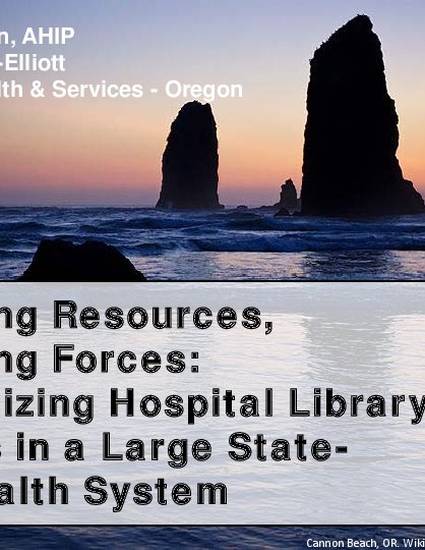
Presentation
Combining resources, combining forces: Regionalizing hospital library services in a large statewide health system
Presentation at the annual meeting of the Medical Library Association.
(2014)
Abstract
Objectives: Amidst declining full-time equivalents (FTEs) and budgets, four hospital libraries were forced to adapt in order to survive or possibly even thrive. This paper describes the experience, including process, challenges, and lessons learned of an organizational shift to a regionalization of services, collections, and staffing. Insights from this process are shared and may help similar organizations going through restructuring, centralization, or mergers.
Methods: After an FTE reduction, 2 libraries situated in large teaching hospitals and 2 in small community hospitals in a western US statewide health system saw opportunity for expansion through a regional reorganization. Strategic planning and stakeholder interviews identified strengths, growth areas, and threats to successful implementation of a regional structure and established a plan for moving forward. Service areas were expanded to include the entire statewide health system. While FTE stayed static, the staffing model was reorganized, with a team approach reporting to a regional director. Eliminating duplicate subscriptions and cutting 80% of print titles, allowed for an addition of 100+ electronic titles, despite significant cost increases to license e-resources to the entire health system, and expanding linking options dramatically improved findability. A regional intranet site was created to provide a single entry point, and a remote access solution developed.
Results: Despite a loss of 2/3 of the professional staff and a budgetary decrease of 27% over the previous 3 years, the health sciences libraries were able to grow business, usage, awareness, and collections through organizational innovation and improved efficiency following regionalization. The regionalization of the health sciences libraries was considered a success by library staff and administration. Initial usage statistics from the first year of regionalization show an average monthly increase of 25% in literature search requests and 6% in document delivery requests, demonstrating successful outreach, and an increase in internal efficiency as FTE was not adjusted to match increased business.
Conclusions: The regional library system in this state is seen as a model for regionalizing services and responsiveness to organizational change. It has been considered for replication in an additional statewide region of the parent health care system, as well as for a broader centralization of the five-state health care system.
Keywords
- hospital libraries,
- medical libraries,
- regionalization,
- library service integration
Disciplines
Publication Date
May 19, 2014
Location
Chicago, IL.
Citation Information
Heather J Martin and Basia Delawska-Elliott. "Combining resources, combining forces: Regionalizing hospital library services in a large statewide health system" Presentation at the annual meeting of the Medical Library Association. (2014) Available at: http://works.bepress.com/barbara-delawska-elliott/11/